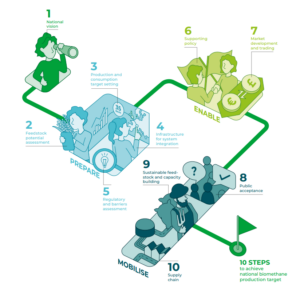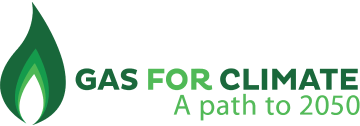Gas for Climate publishes a 10-step implementation manual supporting Member States in planning and achieving national biomethane targets.
The EU’s 35 bcm biomethane target for 2030 has to be translated into individual contributions by all member states. To assist with the implementation of the REPowerEU Plan, the European Commission published a Biomethane Action Plan setting out measures to be taken at both national and European levels to scale up biomethane production and consumption. The plan includes a recommendation to member states to develop a national biomethane strategy as soon as possible.
Gas for Climate has compiled this step-by-step manual to support member states in developing and implementing their national biomethane strategies. The ten steps, from developing a national vision on biomethane and setting initial targets to having a fully implemented national biomethane strategy, are shown below. The steps have a logical flow, but some can be done in parallel. For example, once a member state has a national vision on biomethane, they can already start to mobilise stakeholders and public acceptance to build a constructive and ongoing dialogue.
The urgency to scale-up biomethane production is high. Therefore, this manual emphasises actions that are immediately implementable and that build on research already done across the sector. The steps are complemented with some examples of best practices. These best practice examples aim to highlight different successful trajectories that have been taken to achieve each of the ten steps.
This manual is published in the context of the upcoming Biogas and Biomethane Industrial Partnership (BIP). The BIP is recommended in the European Commission’s Biomethane Action Plan and will launch at the end of September 2022. This manual is intended to feed directly into Task Force 1 of the BIP, which consists of EU member states, the European Commission and the biomethane value chain, and through which an active dialogue and recommendations will be made towards member state biomethane targets and their National Energy and Climate Plans (NECPs) to 2030.
The 10 steps to develop and implement national biomethane strategies
- National vision
- Feedstock potential assessment
- Production and consumption target setting
- Infrastructure for system integration
- Regulatory and barriers assessment
- Supporting policy
- Market development and trading
- Sustainable feedstock and capacity building
- Supply chain
- Public acceptance

Read the full publication here.

